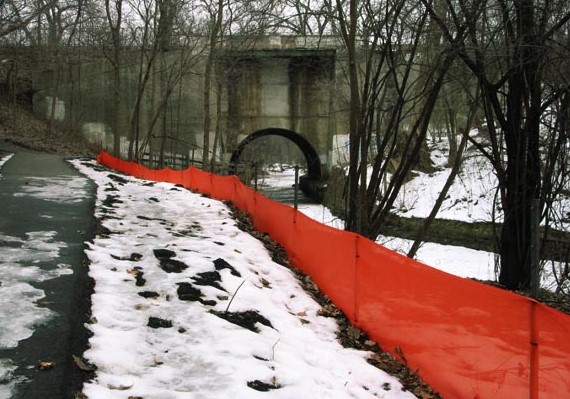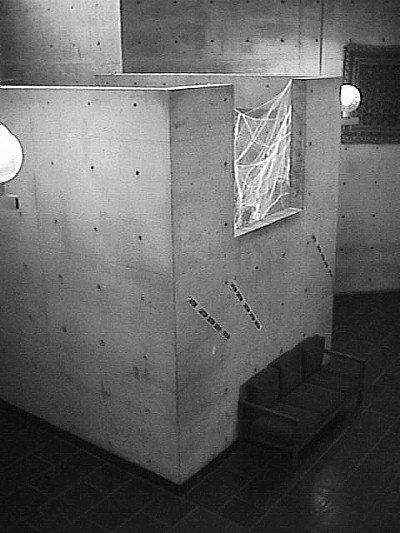2005.02.23 10:26
redux: things architecturalized
To: design-l
Subject: things architecturalized
Date: 2001.11.11 20:48
Brian, I like what you say about,"things architecturalized, architecture without architecture, such as construction sites, for buildings or not, as a way of understanding how the process of building and taking apart works. one example here in Minneapolis is that the parkway system is under construction, and there are orange ribbons of about 2 foot high fencing running along the creek/crik, for miles, Christo-like. else, other events that could be architectural, in the sense of materials, organization, and whatnot."

Almost two weeks ago I visited and photographed Louis Kahn's Bryn Mawr Dormitory, which I didn't know was currently being renovated. There was scaffolding around most of the building, and in some places the exterior slate paneling was removed. Rather than being upset that "good" pictures could now not be taken, I took lots of "new" construction shots -- recording architecture as it really exists. Inside the dorm was much as I remember it (my last time there was 1989), but the huge clerestory windows do need a real washing. Since I was there the day before Halloween there were various Halloween decorations in the main stair hall, like fake spider webs in the large concrete cut-outs. Kinda went with the scaffolding outside.
| |


Louis I. Kahn Erdman Hall 2001.10.30
| |
2005.02.23 11:25
Re: redux: things architecturalized
...I'm glad you recorded the parkway construction. I vaguely recall you posting an image or two back then. Anyway, it would be neat to have your images side-by-side with images of the current GATES in Central Park. No rush in finding the images though, I know what you mean about having to go through many discs to find stored data.
The pre-Halloween images of Kahn's Bryn Mawr Dormitory are somewhat dull because it was late afternoon and cloudy when the images were taken. The images with the Halloween decorations inside are fun to see, however, and I will post them at quondam soon. There was a post to design-l or architecthetics entitled "Kahn in cobwebs" were one of the images was featured. [It still bothers me that Howard privatized the original design-l archive--kinda like things assholedized. Sorry, I couldn't help myself.]
Good luck with your planned 'photography' experiment. I look forward to seeing some of the results.
One of the few times I converted color digital images into grayscales was with the Bryn Marw Dorm images, and I was somewhat surprised how different the images became. They actually looked more aesthetic for some reason. Looks like I may be doing some experimenting myself.
ps
just looked at the orange fence image at mnartists -- very, very interesting! I love the whole "who's reenacting who?" quondam quandary.
2005.02.25 11:04
Re: body of work- prolific output or serial investigation? - Unbekannt
"uMean da shoppin' center?"
or 1900 Bertolucci's
"I don't want to see! I don't want to see anymore! I'm blind!!! I'm blind!!!"
Might just start working on another 'book' entitled quondam cum movies. I'm also likin' how my neighborhood is starting to show more North Philadelphia Latin Quarter influence.
2005.02.25 11:11
Re: body of work- prolific output or serial investigation? - Unbekannt
Vanessa wo bist du?
2005.02.25 11:49
Re: [dis]content .1
...thanks for adding references regarding 'reverse salients'. Interesting stuff and seemingly worthwhile methodology.
Funny, when thinking of flaws, I'm also reminded of the 'quest for the flawless' in current popular (mostly American?) culture--the extreme makeover craze, etc. "metabolic slash delivery" indeed!
One flaw in architecture culture I'd like to see fixed is for 'history' to portray late Roman architecture and early Christian architecture within at least the same 'chapter'. The two 'styles' really played an integral role with each other, and that 'history' isn't even addressed, let along recognized.
Anyway, since it's Breaking the Silence Day, here's to everyone now knowing that Constantine has an older half-sister via his mother. By the time they met Eutropia in Palmyra, Maximian, Helena, Theodora, Constantius and Constantine were already a tight little bunch. Theodora was immediately enthralled with Eutropia, and a wonderful 'step-mother-daughter' relationship blossomed. Ultimately, Helena and Eutropia became the best stealth operators of late antiquity. Even Constantine didn't know until he was over fifty that his step-mother was also his half-sister.
Perhaps it's also worth mentioning that many components of this convoluted blood line were architecture keen.
|